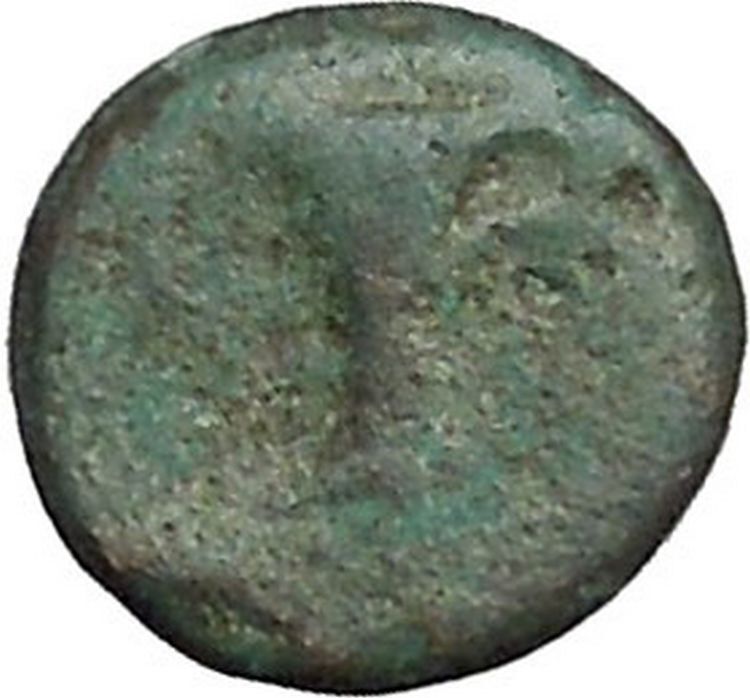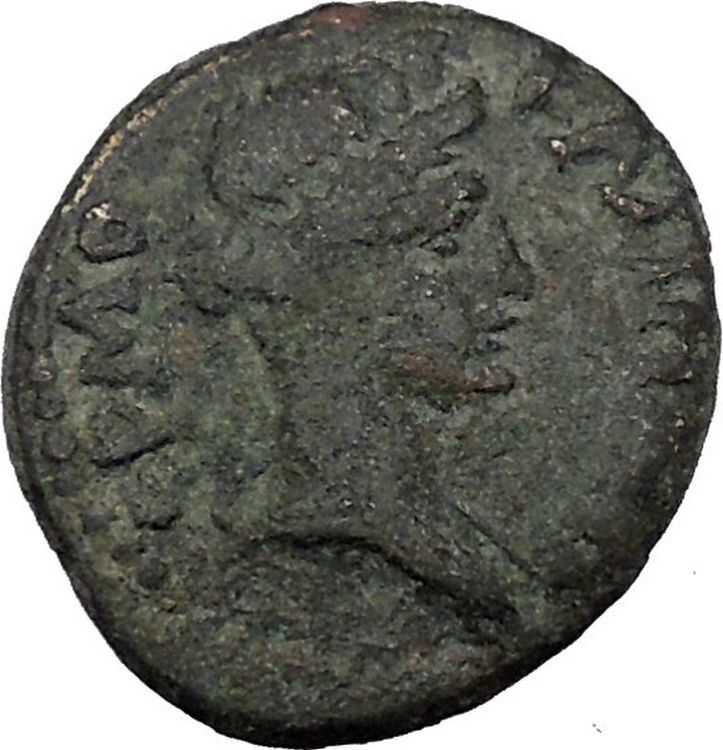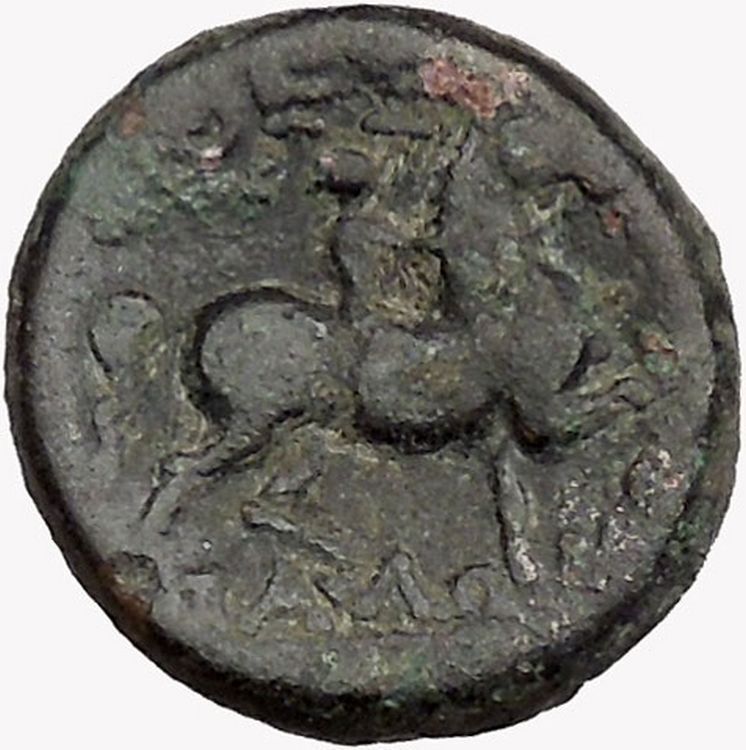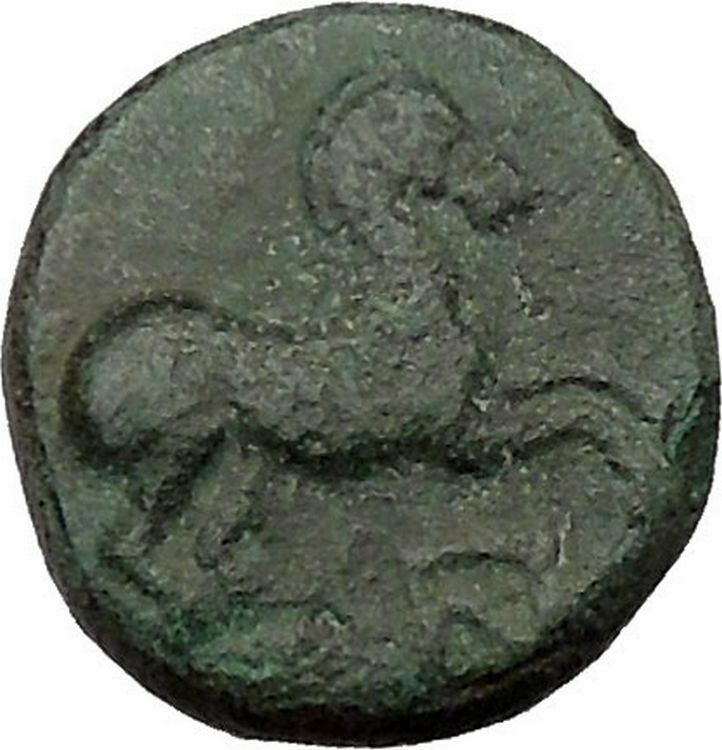|
Greek city of
Phalanna
(on the Peneios, a few miles upstream
from Larissa) in Thessaly
Bronze 15mm (4.46 grams) Struck circa 350 B.C.
Reference: Sear 2180; B.M.C. 7. 10, var.
Young male head right, T behind head.
ΦΑΛΑΝΝΑΙΩΝ, Head of
nymph
Phalanna right, hair in sakkos.
You are bidding on the exact item pictured,
provided with a Certificate of Authenticity and Lifetime Guarantee of
Authenticity.
A nymph in
Greek mythology
and in
Latin mythology
is a minor female nature deity
typically associated with a particular location or landform. There are 5
different types of nymphs, Celestial Nymphs, Water Nymphs, Land Nymphs, Plant
Nymphs and Underworld Nymphs. Different from goddesses, nymphs are generally
regarded as divine spirits who animate nature, and are usually depicted as
beautiful, young nubile
maidens who love to dance and sing;
their amorous freedom sets them apart from the restricted and chaste wives and
daughters of the Greek
polis
. They are believed to dwell in
mountains and
groves
, by springs and rivers, and also in
trees and in valleys and cool
grottoes
. Although they would never die of old
age nor illness, and could give birth to fully immortal children if mated to a
god, they themselves were not necessarily immortal, and could be beholden to
death in various forms.
Charybdis
and
Scylla
were once nymphs.

Other nymphs, always in the shape of young maidens, were part of the
retinue
of a god, such as
Dionysus
,
Hermes
, or
Pan
, or a goddess, generally the huntress
Artemis
.[1]
Nymphs were the frequent target of
satyrs
. They are frequently associated with the
superior divinities: the huntress
Artemis
; the prophetic
Apollo
; the reveller and god of
wine,
Dionysus
; and rustic gods such as Pan and
Hermes.
Etymology
Nymphs are personifications of the creative and fostering activities of
nature, most often identified with the life-giving outflow of springs: as
Walter Burkert
(Burkert 1985:III.3.3) remarks,
“The idea that rivers are gods and springs divine nymphs is deeply rooted not
only in poetry but in belief and ritual; the worship of these deities is limited
only by the fact that they are inseparably identified with a specific locality.”
The
Greek
word
νύμφη has “bride” and “veiled” among its meanings: hence a marriageable
young woman. Other readers refer the word (and also
Latin
nubere and
German
Knospe) to a root expressing the
idea of “swelling” (according to
Hesychius
, one of the meanings of
νύμφη is “rose-bud”).
Greek deities
series |
|
Primordial deities
|
Titans
and
Olympians
|
|
Aquatic deities
|
|
Chthonic deities
|
|
Personified concepts
|
|
Other deities |
-
Asclepius
, god of
medicine
- Leto
, mother of
Apollo
and Artemis
-
Pan
,
shepherd
god
|
|
Nymphs |
- Alseid
-
Auloniad
- Aurai
-
Crinaeae
- Dryads
-
Eleionomae
-
Hamadryads
-
Hesperides
-
Limnades
- Meliae
|
- Naiads
- Napaeae
- Nereids
- Oceanids
- Oreads
- Pegaeae
-
Pegasides
-
Pleiades
-
Potamides
|
Adaptations
The Greek nymphs were spirits invariably bound to places, not unlike the
Latin genius loci
, and the difficulty of
transferring their cult may be seen in the complicated myth that brought
Arethusa
to Sicily. In the works of the
Greek-educated
Latin poets
, the nymphs gradually absorbed into
their ranks the indigenous Italian divinities of springs and streams (Juturna,
Egeria
,
Carmentis
,
Fontus
), while the
Lymphae
(originally Lumpae), Italian
water-goddesses, owing to the accidental similarity of their names, could be
identified with the Greek Nymphae. The mythologies of classicizing Roman poets
were unlikely to have affected the rites and cult of individual nymphs venerated
by country people in the springs and clefts of
Latium
. Among the
Roman
literate class, their sphere of influence
was restricted, and they appear almost exclusively as divinities of the watery
element.
In modern Greek
folklore

A Sleeping Nymph Watched by a Shepherd by
Angelica Kauffman
, about 1780, (V&A
Museum no. 23-1886)
The ancient Greek belief in nymphs survived in many parts of the country into
the early years of the twentieth century, when they were usually known as “nereids“.
At that time, John Cuthbert Lawson wrote: “…there is probably no nook or
hamlet in all Greece where the womenfolk at least do not scrupulously take
precautions against the thefts and malice of the nereids, while many a man may
still be found to recount in all good faith stories of their beauty, passion and
caprice. Nor is it a matter of faith only; more than once I have been in
villages where certain Nereids were known by sight to several persons (so at
least they averred); and there was a wonderful agreement among the witnesses in
the description of their appearance and dress.”[2]
Nymphs tended to frequent areas distant from humans but could be encountered
by lone travelers outside the village, where their music might be heard, and the
traveler could spy on their dancing or bathing in a stream or pool, either
during the noon heat or in the middle of the night. They might appear in a
whirlwind. Such encounters could be dangerous, bringing dumbness, besotted
infatuation, madness or stroke to the unfortunate human. When parents believed
their child to be nereid-struck, they would pray to Saint Artemidos.[3][4]
Modern sexual
connotations

The Head of a Nymph by
Sophie Anderson
Due to the depiction of the mythological nymphs as females who mate with men
or women at their own volition, and are completely outside male control, the
term is often used for women who are perceived as behaving similarly. (For
example, the title of the
Perry Mason
detective novel The Case of the
Negligent Nymph (1956) by
Erle Stanley Gardner
is derived from this
meaning of the word.)
The term
nymphomania
was created by modern
psychology
as referring to a “desire to engage
in
human sexual behavior
at a level high enough to
be considered clinically significant”, nymphomaniac being the person
suffering from such a disorder. Due to widespread use of the term among lay
persons (often shortened to nympho) and stereotypes attached,
professionals nowadays prefer the term
hypersexuality
, which can refer to males
and females alike.
The word
nymphet
is used to identify a sexually
precocious girl. The term was made famous in the novel
Lolita
by
Vladimir Nabokov
. The main character,
Humbert Humbert
, uses the term many times,
usually in reference to the title character.
Classification
As
H.J. Rose
states, all the names for various
classes of nymphs are plural feminine adjectives agreeing with the substantive
nymphai, and there was no single classification that could be seen as
canonical and exhaustive. Thus the classes of nymphs tend to overlap, which
complicates the task of precise classification. Rose mentions
dryads
and
hamadryads
as nymphs of trees generally,
meliai
as nymphs of
ash trees
, and
naiads
as nymphs of water, but no others
specifically.[5]
Classification by type of dwelling
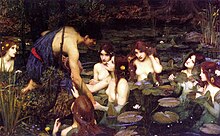
Hylas
and the Nymphs by
John William Waterhouse
, 1896
The following[6]
is not the authentic Greek classification, but is intended simply as a guide:
- Celestial nymphs
-
Aurae
(breezes), also called Aetae or
Pnoae
- Asteriae (stars), mainly comprising the Atlantides (daughters of
Atlas
)
-
Hesperides
(nymphs of the West,
daughters of Atlas; also had attributes of the
Hamadryads
)
-
Aegle
(“dazzling light”)
-
Arethusa
-
Erytheia
(or Eratheis)
-
Hesperia
(or Hispereia)
-
Hyades
(star cluster; sent rain)
-
Pleiades
(daughters of
Atlas
and
Pleione
; constellation; also were
classed as
Oreads
)
Thessaly was home to an extensive
Neolithic
culture around
2500 BC
.
Mycenaean
settlements have also been discovered, for example at the sites of
Iolcos
,
Dimini
and
Sesklo
(near
Volos
). Later, in
ancient Greek
times, the lowlands of Thessaly became the home of baronial
families, such as the
Aleuadae
of
Larissa
or
the Scopads of Crannon. These baronial families organized a federation across
the Thessaly region, later went on to control the
Amphictyonic League
in northern Greece. The
Thessalians
were renowned for their cavalry.
In the summer of
480 BC
, the
Persians invaded Thessaly. The Greek army that guarded the
Vale
of Tempe
, evacuated the road before the enemy arrived. Not much later,
Thessaly surrendered. The Thessalian family of
Aleuadae
joined the Persians. In the
Peloponnesian War
the Thessalians tended to side with Athens and usually
prevented Spartan troops from crossing through their territory with the
exception of the army of Brasidas.
Jason of Pherae
briefly transformed the country into a significant military
power, though he was assassinated before any lasting achievements were made. In
the 4th century BC
Thessaly became dependent on
Macedon
and many served as vassals. In
148 BC
the
Romans formally incorporated Thessaly into the province of
Macedonia
, though in 300 AD Thessaly was made a separate province with its
capital at Larissa
.
It was part of the Byzantine Empire and suffered many
invasions. In 977 it was occupied by the Bulgarians, who remained there until
1014. In 1204 he was assigned to
Boniface of Montferrat
and in 1225 to
Theodore Komnenos Doukas
, despot of
Epirus
. From
1271 to 1318 he was an independent despotate that extended to
Acarnania
and Aetolia
,
run by John III Angelos Komneno. In 1309 settled there the
Almogavars
or
Catalan Company
of the East (Societas Catalanorum Magna), which in 1310,
after lifting the siege of Thessalonica, withdrew as mercenaries in the pay of
the sebastocrátor
John II, and took over the country organized in a democracy.
From there went to the
Duchy of Athens
called by the duke Walter I. In 1318, with the extinction of
the dynasty of Angelos, the Almogavars occupied Siderocastron and southern
Thessaly (1319) and formed the
duchy of Neopatria
.
Later it was occupied by the
Serbs
until 1393,
after being dominated by the
Ottomans
. In 1821 participated in the
Greek War of Independence
, but was not recognized as part of
Greece
until
1881.
|









